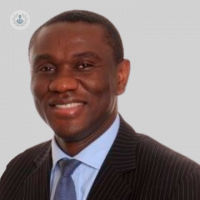Might gynaecomastia be a sign of an underlying condition?
Written by:In one of our latest medical articles here below, Mr Fortune Iwuagwu, a highly experienced consultant plastic, reconstructive, and hand surgeon, details what causes gynaecomastia, and reveals whether or not it may be a sign of another, more serious underlying condition.

What is gynaecomastia, and what can it cause?
Gynaecomastia is a condition that causes swelling of the breast tissue in males due to an imbalance of sex hormones. Males and females have both female and male sex hormones in different proportions; and in gynaecomastia, there is increased sensitivity of the breast tissue in the male to the female sex hormone. It can occur in one or both breasts, and can cause sensitivity and/or pain.
What are the common causes of gynaecomastia?
It can occur normally in babies, teenagers, and elderly patients. It can occur due to the abuse of anabolic steroids, use of recreational drugs like marijuana, some antihypertensives, and anti-peptic ulcer medication, just to mention a few.
Might it be a sign of an underlying condition?
The condition is usually benign and idiopathic (no known cause) and resolves on its own within six months to two years. However, it can be a sign of an underlying medical condition such as hypogonadism, hyperthyroidism, tumours, renal failure, liver failure, or cirrhosis.
What are the warning signs of gynaecomastia?
Some of the warning signs of gynaecomastia include swollen breast gland tissue, breast tenderness, nipple discharge in one or both breasts, and breast asymmetry. If you notice any of these symptoms, it’s important to see your doctor for an evaluation.
How is gynaecomastia treated?
Treatment for gynaecomastia depends on the underlying cause. In most cases, the condition resolves on its own without treatment. However, if the condition is caused by an underlying medical condition or medication use, treating the underlying cause may help resolve the gynaecomastia. In some cases, surgery may be necessary to remove the excess breast tissue.
What are the main associated complications?
Complications of gynaecomastia are rare, but can include emotional or psychological problems due to changes in physical appearance. People may feel embarrassed to undress in front of others, and can be teased by others because of the appearance of the breasts.
What does gynaecomastia surgery involve?
Gynaecomastia surgery, also known as reduction mammoplasty, is an elective, cosmetic procedure performed to reduce the size and improve the appearance of overdeveloped breast tissue in men. The procedure is tailored to the patient and may involve liposuction, tissue excision, excess skin removal and/or surgical adjustments to the areola.
The surgery is performed under general anaesthesia and medications are administered for your comfort during the surgical procedure(s). After surgery, you’ll need to watch out for signs of infection such as fever, inflammation, swelling, and unusual drainage. Recovery time varies depending on the extent of the surgery, but most patients can return to work within a few weeks, depending on your occupation.
If you wish to consult with Mr Fortune Iwuagwu, book an appointment with him today via his Top Doctors profile.


